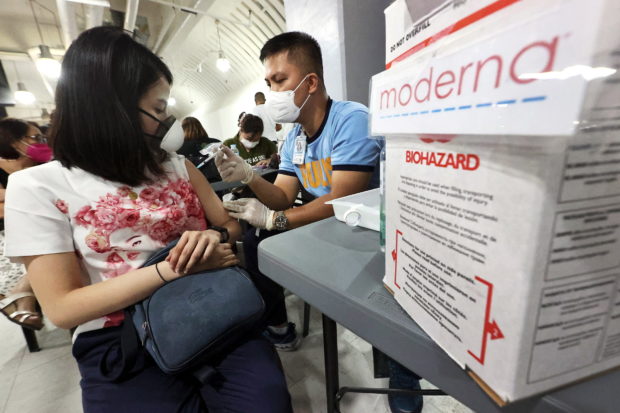
ADDED PROTECTION The San Juan City government rolls out its second booster dose of COVID-19 vaccine for immunocompromised adults on April 26. —GRIG C. MONTEGRANDE
MANILA, Philippines — It is “high time” that the country’s general population be required to get COVID-19 booster shots for added protection as more workplaces open and in-person classes resume, infectious disease expert Dr. Rontgene Solante said during Monday’s Laging Handa briefing.
Solante, a member of the Department of Health’s (DOH) technical advisory group and an adviser to the Inter-Agency Task Force for the Management of Emerging Infectious Diseases (IATF), made the call for a booster mandate in the wake of the ongoing “weak surge” in infections and the higher positivity rates noted in recent weeks.
The DOH on Monday said the average daily new coronavirus cases last week surged by 39 percent to 1,467 from 1,057 the previous week.
The DOH pointed out that of the 10,271 confirmed new cases last week, 27 were in severe or critical condition. COVID-19 admissions also slightly increased but remained at low levels, it added.
“The uptake of our booster shots is really low. So I think it’s high time that we mandate booster vaccination for the general population. It has to be mandatory so that we can increase protection, especially now that we are preparing for face-to-face classes and workplaces are also open now,” Solante said.
He noted that the number of Filipinos who received booster shots was less than 20 percent of the target population.
Data from the DOH showed that only 15.18 million Filipinos have received booster shots, while 71.04 million have completed their primary doses of the COVID-19 vaccine.
In comparison, the Philippines’ neighbors such as Vietnam, Singapore, Malaysia and Thailand were able to administer booster shots to half of their target population, Solante said.
Regular vaccination
The health expert also noted the possibility of administering COVID-19 vaccinations on a regular basis to address emerging variants of concern in the future.
“We know that the COVID-19 virus mutates and changes shape to the point that the vaccines used in the primary series have lower protection now. There is a possibility that with the next few months remaining, moving forward, we cannot control this because of the possibility of new, more variants of concern that would lower the efficacy of the vaccines,” Solante said.
“That’s one of the things we’re looking at, that there’s a possibility that vaccinations will be regular—whether it’s three months, four months or six months. It depends on the studies on what vaccines should be given regularly, and depending on the prevailing, dominant variants in that particular year,” he added.
Solante said the “weak surge” of infections predicted by OCTA Research was “starting now,” given the increases in COVID-19 positivity rates.
“The positivity rate, the newly infected individuals based on that positivity rate is starting to rise,” he said.
As of July 9, data released by OCTA Research showed that the positivity rate in Metro Manila was at 10.9 percent, while the DOH said the nationwide positivity rate was at 6.8 percent.
The uptick in recent cases is largely due to more transmissible Omicron subvariants of the virus.
OCTA Research fellow Guido David said they were not expecting cases to rise drastically in Metro Manila as the growth rate has slowed down to 31 percent from 62 percent the previous week.
“In Metro Manila, the peak may be in mid-July or delayed by late July. We expect more than 1,000 cases or maybe up to 2,000 cases a day in Metro Manila, if it is prolonged maybe even 3,000 cases a day,” David said in the same briefing.
He added that more areas might report a higher positivity rate in the coming days.
Low healthcare usage
Solante and David agreed that even with a slight uptick in cases, there was no need to declare a higher COVID-19 alert level for Metro Manila or other parts of the country.
“There’s no need to upgrade the alert level because this is expected for a virus that is highly transmissible. The important thing is to increase our boostered population to 70 percent so that there will be less chances of transmission,” he said.
He also emphasized the importance of monitoring the healthcare utilization rate and continuing to follow minimum health standards such as wearing face masks and washing hands, among others.
“We can live with this virus. We may not have more severe cases, and this virus may not disrupt our livelihood with these measures in place. Not to the point we will need a higher alert level at this point in time,” Solante said.
According to the latest DOH bulletin, 411 or 17 percent of the 2,414 COVID-19 intensive care unit (ICU) beds were occupied, while 4,863 or 22.7 percent of the 21,424 non-ICU beds were in use.
Health Undersecretary Maria Rosario Vergeire also noted that severe and critical cases and hospitalizations remained low despite the increasing cases.
“What’s important is that we keep severe and critical cases at a minimum. What’s also important is that the deaths are at a minimum, and the most important thing is that our hospitals do not become congested,” she said in a radio interview on Monday.
RELATED STORIES
EU recommends second Covid booster jab for over 60s —health agencies
PH booster coverage still below 50%
Around 40 million eligible Filipinos yet to receive 1st booster shot — DOH